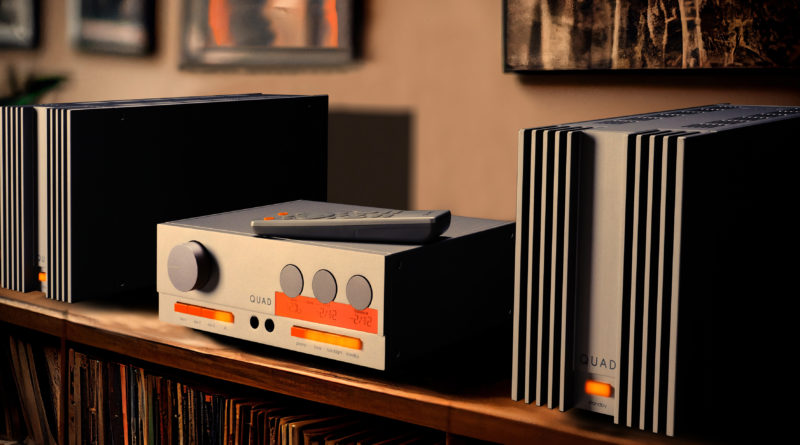QUAD 33 & 303 RE-IMAGINED!
The QUAD 33 and 303 pre-power amp combo is nearly as old as me, and now these classics of British Audio have been brought up to date. Read on for the full skinny (Ed.)
Icons of British audio
Born in the Swinging Sixties, the famous QUAD 33 preamp and 303 power amp return in fresh, revitalised form to delight a new generation of music lovers seeking a modern-retro twist. One of the most celebrated amplifiers of all time – the 33/303 two-box pre/power amp system from QUAD, Britain’s original high-end hi-fi brand – makes a triumphant return 57 years after it first recalibrated expectations for transistor-based sound.
Teased in prototype form at the High End audio show in Munich in May, the reimagined QUAD 33 preamplifier and QUAD 303 stereo power amplifier were among the most hotly anticipated hi-fi launches of 2024. This reflects not only the appeal of modern-retro design in audio, but also the high esteem in which the original amps are held – the 33 and 303 remain among the most sought-after ‘vintage’ amplifiers on the second-hand market.
Upon their launch in 1967, their innovative circuit design elevated transistor-based amplification to new heights. The new 33/303 contain highly evolved versions of the same signature technologies, wrapped in an industrial design that echoes the past and embraces the future.
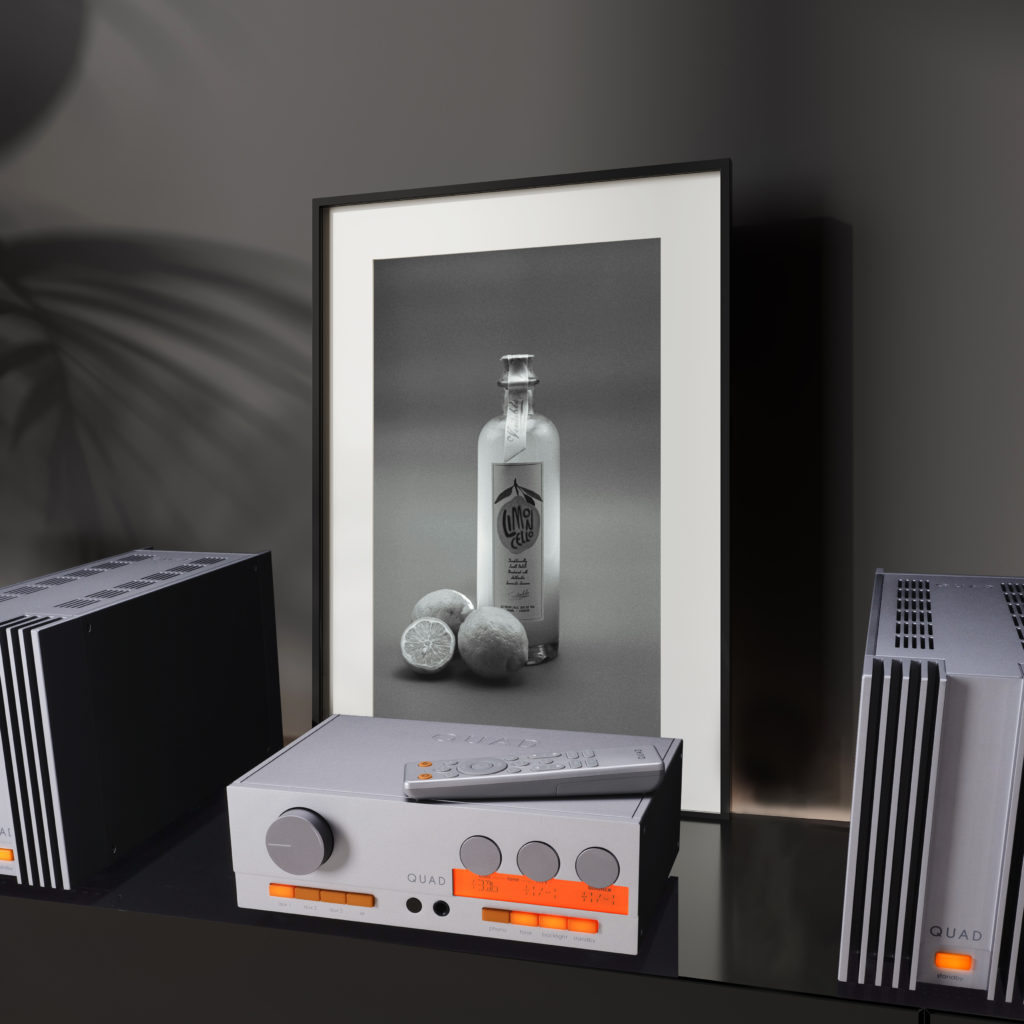
History Revisited
Transistor-based amp technology was still relatively new in the mid-1960s, with valve-based circuits continuing to dominate the most highly prized hi-fi amplifiers from a sound quality perspective. The 33 preamp and 303 stereo power amp were QUAD’s first transistor designs, following several revered valve amplifiers, and were highly unusual inside and out.
For start, most transistor amps of the time were integrated models with the preamp and power amp stages – and often a radio tuner – combined in a single box. QUAD’s design housed the preamplifier and power amplifier in separate compact-width units (there was a separate FM tuner too).
The 303 power amp, with its distinctive vertical orientation and prominent heatsink fins, was designed so it could be tucked away from view if the user desired, leaving only the 33 preamp in view. The latter was truly a design triumph of its time, its grey metal casework accented by orange and white buttons and flush-mounted rotary controls earning it and its partnering power amp a Council of Industrial Design Award in 1969. Today, the 33’s design has gained iconic status, confirmed by its presence at the Museum of Modern Art in New York.
Under the lid, QUAD’s founder Peter Walker introduced several innovations that set the 33/303 combination apart. Chief among these was the 303’s ‘triples’ transistor output configuration, which solved the thermal instability problems that plagued early transistor amp designs. This circuit topology produced impressively low distortion, prompting QUAD to promote the 303 as “the world’s first low distortion transistor amplifier”.
The sound of the original QUAD 33/303 pre/power amp combination was indeed something special. It is sometimes thought of as ‘warm’, especially in the context of typical solid-state amplifiers of the time, which by comparison sounded rather hard and sometimes harsh. Its richer style of sound made it less fatiguing to listen too, yet there was no shortage of detail and engaging ‘punch’ – some of the attributes of a good valve amplifier combined with the benefits of a compact, efficient, cool-running transistor design, one might say. The fact that 33 and 303 amps made in the 1960s and ’70s are still sought by enthusiasts today pays tribute to their enduring qualities in terms of sound, design and reliability.
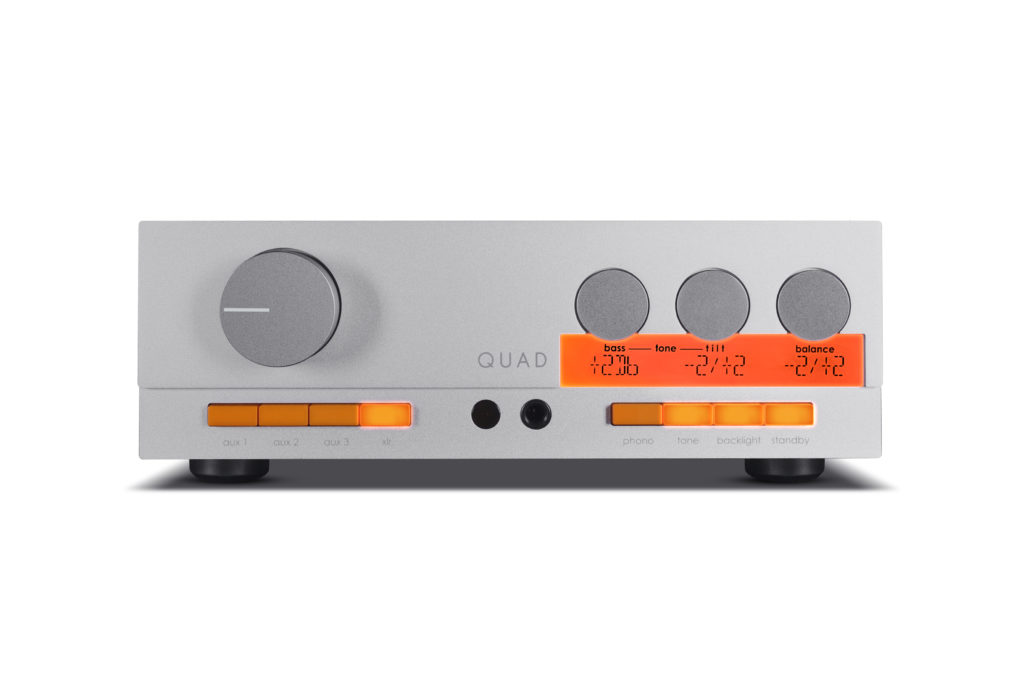
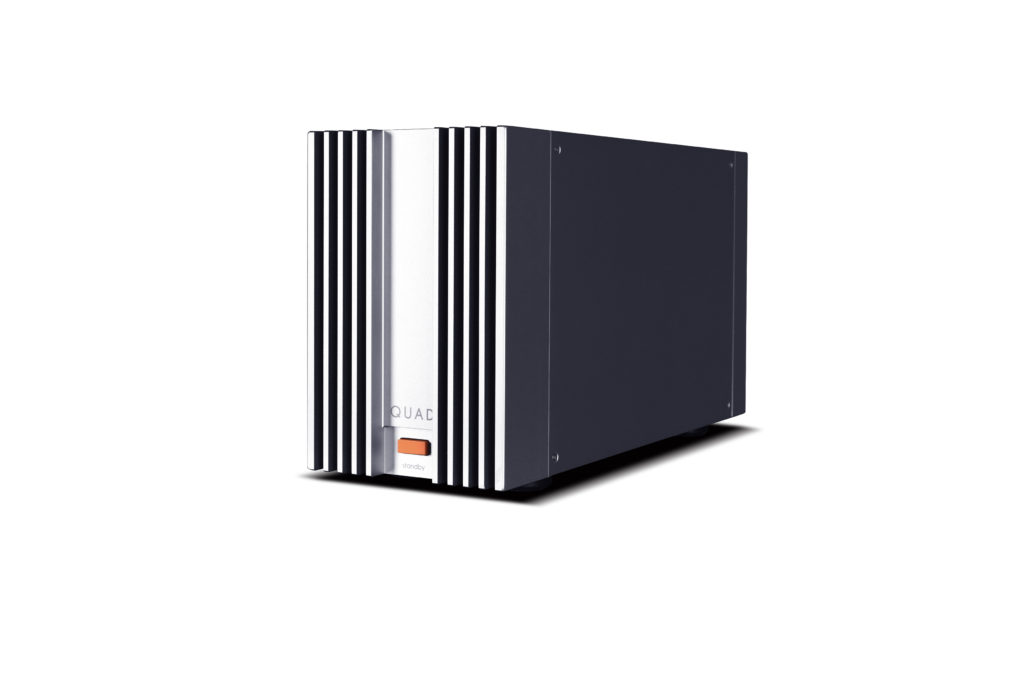
Design Evolution
QUAD’s decision to revisit the 33 and 303 was in no small part due to the continuing demand for these amps on the second-hand market some four decades after they were discontinued in the 1980s. What 2 a tempting proposition, to take such an iconic design and update it inside and out, creating a new amp pairing that is unmistakably a QUAD 33/303 yet benefitting from the advances in design, engineering and manufacturing in the 57 years since the original was first realised…
To achieve this vision, QUAD assembled a formidable in-house team at its HQ in Huntingdon, Cambridgeshire, led by four esteemed individuals:
▪ Jan Ertner: lead electronics designer for QUAD and sister-brand Audiolab.
▪ Rob Flain and Paul McConville: QUAD’s most experienced service engineers – nobody knows the innermost workings of QUAD amplifiers past and present better than these two gentlemen.
▪ David McNeill: QUAD’s industrial design chief for the last two decades.
In due deference to the iconic status of the 33 and 303’s industrial design, McNeill has delivered an evolutionary continuation of the external form rather than a radical overhaul. The new 33 preamplifier’s compact size and shape is faithful to the original, but the detailing has been enhanced and the casework’s grey colour is a little less ‘taupe’ and more ‘matt silver’. The distinctive control layout is similar, with a volume knob to the left and a trio of flush-mounted rotary controls to the right (although the functionality of these controls is now somewhat different).
Crucially, the original 33’s orange accents remain, albeit cleverly updated. The buttons beneath the rotary controls are now all orange (no white), with the addition of LEDs to illuminate them. And the orange strip containing labelling for the three flush-mounted rotaries now includes an LCD display with orange backlighting. Such things were not possible in the 1960s, yet the ingenious way these visual updates have been applied to the new 33 feels entirely in keeping with the classic aesthetic.
The backlit buttons and LCD display – which can be dimmed or switched off entirely – are not the only nods to modern expectations. Between the 33’s two rows of orange buttons are a 6.35mm headphone socket and an IR receiver for the supplied remote control – more ‘mod-cons’ added to the original’s specification. Further differences in the facilities offered by the original 33 and the new 2024 edition are highlighted in the ‘Technology’ section below.
Like the 33, the new 303 stereo power amplifier is instantly recognisable yet smartly updated. The original’s vertical orientation remains, together with the distinctive heatsink fins at the front – albeit there are now ten fins rather than eight, and these have been neatly squared off. The addition of an 3 illuminated orange standby button ties the new 303’s aesthetic with the 33, topped off with QUAD’s musical note symbol etched into the top surface – another classy touch.
The original 33 and 303 were so admired for their reliability and performance that they were not only used in homes; some recording and broadcast studios adopted them too. The new editions have been engineered to offer the same outstanding longevity, supported by QUAD’s world-renowned technical service team led by Flain and McConville who helped design them. In half a century, these new amps may still be providing musical delight in homes around the world, just as the originals do now.
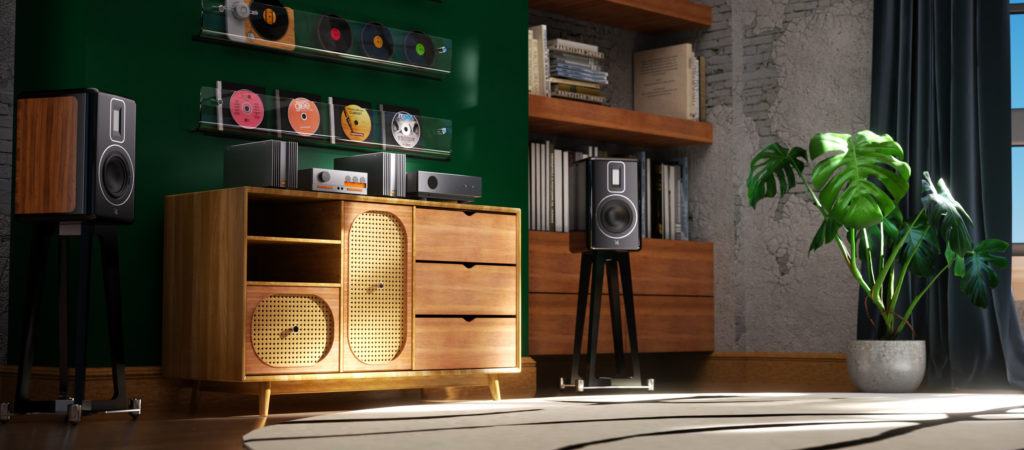
Technology – the new QUAD 33
The original 33 preamplifier was launched at a time when vinyl was king and digital audio was still some 15 years away from entering the domestic scene in the form of CD. It offered several vinyl-oriented facilities for users to tailor the sound, including 5k, 7k and 10k filters, accessed via the buttons beneath the rotary controls for bass, treble and slope adjustment. These filters were intended to remove record surface noise and high frequency distortion when used in concert with the slope dial.
The new 33 remains a staunchly ‘analogue’ preamplifier, with no built-in DAC for digital sources, but its facilities have been adapted to better suit contemporary requirements. For a start, the filters for vinyl have gone and the bass, treble and slope dials have been replaced by bass, tilt and balance.
The ‘Tilt’ control was created by QUAD’s founder Peter Walker as a more sophisticated form of tone control. It was introduced in 1982 on the QUAD 34 preamp, which succeeded the 33; although not contemporary to the original 33, it is considered a classic QUAD feature that remains highly useful and so has been added to the new 33.
Walker believed that traditional bass and treble controls were a rather ham-fisted way of adjusting tonal balance. The tilt control differs by adjusting both ends of the frequency spectrum together, either attenuating the bass and lifting the treble or lifting the bass and attenuating the treble in 1dB steps. Essentially, it rotates – or tilts – the audible frequency range on a 700Hz axis, thereby adjusting the overall sound balance with ‘warm’ or ‘cool’ hints without altering volume or adding colour to the sound.
The tilt control works in tandem with independent bass adjustment, accurately applied from -3dB to +3dB. These subtle, precise and consistent methods of tailoring tonal performance are tremendously useful given the varying quality of the music sources we listen to today, from streaming services to vinyl to hi-res digital files. They also help to tune the sound to suit different acoustic environments and, of course, personal taste.
Connectivity has also evolved. The original 33 used DIN sockets for its inputs and outputs; these have been swapped for a mix of single-ended RCA and balanced XLR sockets, opening up a much wider range of cable options. The original’s four source inputs – labelled ‘disc’ (for vinyl), ‘radio 1’, ‘radio 2’ and ‘tape’ – have been replaced by four line-level inputs (3x RCA and 1x XLR) and a phono input, and there is also a choice of RCA and XLR outputs to connect the 303. Other modern conveniences include two 12V trigger outputs and a USB data input for firmware updates.
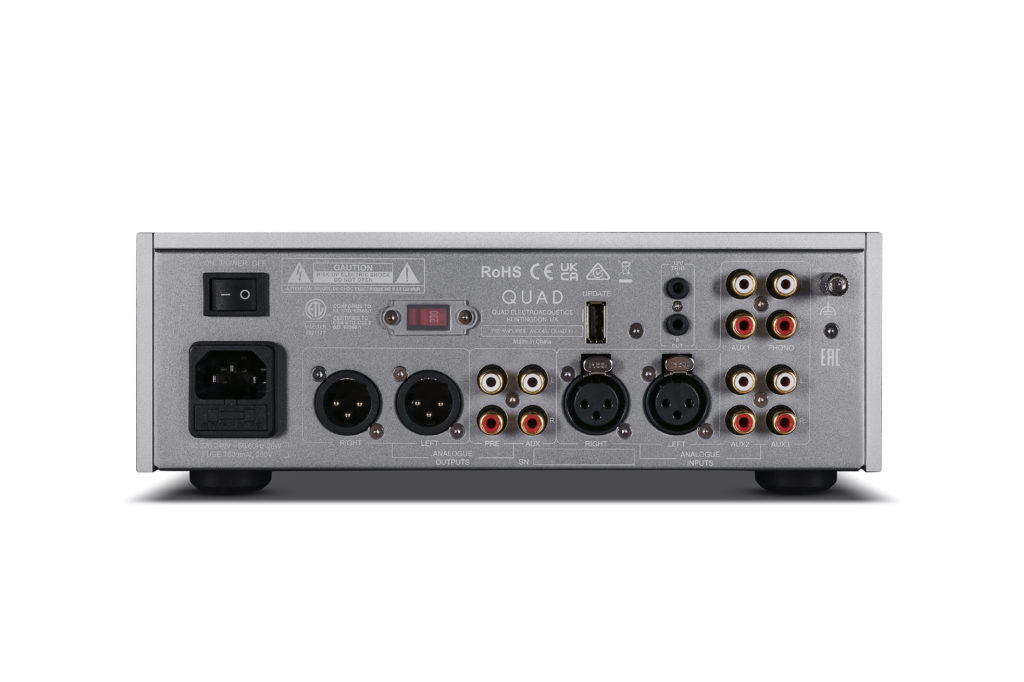
While the latter input shows that the new 33’s user interface is microprocessor controlled, the audio signal path is entirely analogue. A high-quality motorised Alps potentiometer adjusts volume, while the three rotary encoders for bass, tilt and balance provide the precision of digital control but act entirely in the analogue domain – classic QUAD features updated for 2024 and beyond.
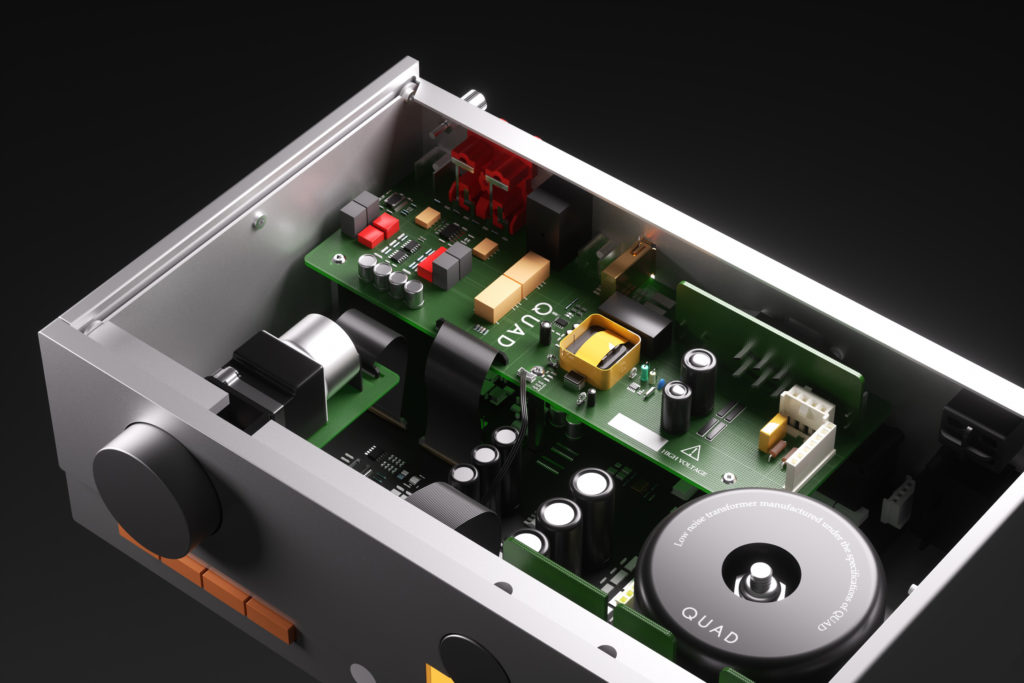
The new 33’s audio circuitry is faithful to the intention of the original – a groundbreaking design of its day – whilst acknowledging that the quality of today’s electronic components is vastly better than those available in the 1960s. The design team has created an entirely new circuit design, including a lownoise, custom-specified toroidal transformer, numerous reservoir/smoothing capacitors and five regulated supply rails, remaining true to the original’s ethos whilst improving on its sonic performance.
The new 33’s low-noise phono stage is also a significant advance on the original’s, with adjustable gain for MM and MC cartridges, precise RIAA equalisation, precision input filtering and an upgraded power supply, delivering every drop of detail dug from a vinyl record’s grooves. As for the dedicated headphone amp – an entirely new addition – its current-feedback design and high slew rate ensures a dynamic and detailed performance with all manner of headphones.
Technology – the new QUAD 303
The original 303 stereo power amplifier was (and still is) admired by hi-fi enthusiasts and studio professionals alike for three reasons: its exceptional reliability, the positional flexibility permitted by its compact form, and its smooth yet energising and richly detailed sound. All these attributes are equally applicable in a modern context to the new 303, which evolves the core circuit design of QUAD’s innovative original using today’s techniques and technologies.
Peter Walker’s great circuit innovation for the 303 – the ‘triples’ output stage – remains at the new amplifier’s heart. A breakthrough in transistor amp design, it effectively forms a feedback amplifierwithin-an-amplifier, requiring far less negative feedback, possessing exemplary thermal stability (meaning the current in the output stage is practically immune to temperature fluctuations) and producing lower distortion.
Whilst updated with the finest modern circuit components, the new 303’s ‘symmetrical triples’ design is faithful to the original, providing a completely symmetrical output stage and rendering the resting current independent of output transistor temperature. Distortion is reduced to emphatically low levels without sacrificing stability, maintaining this performance under all dynamic conditions.
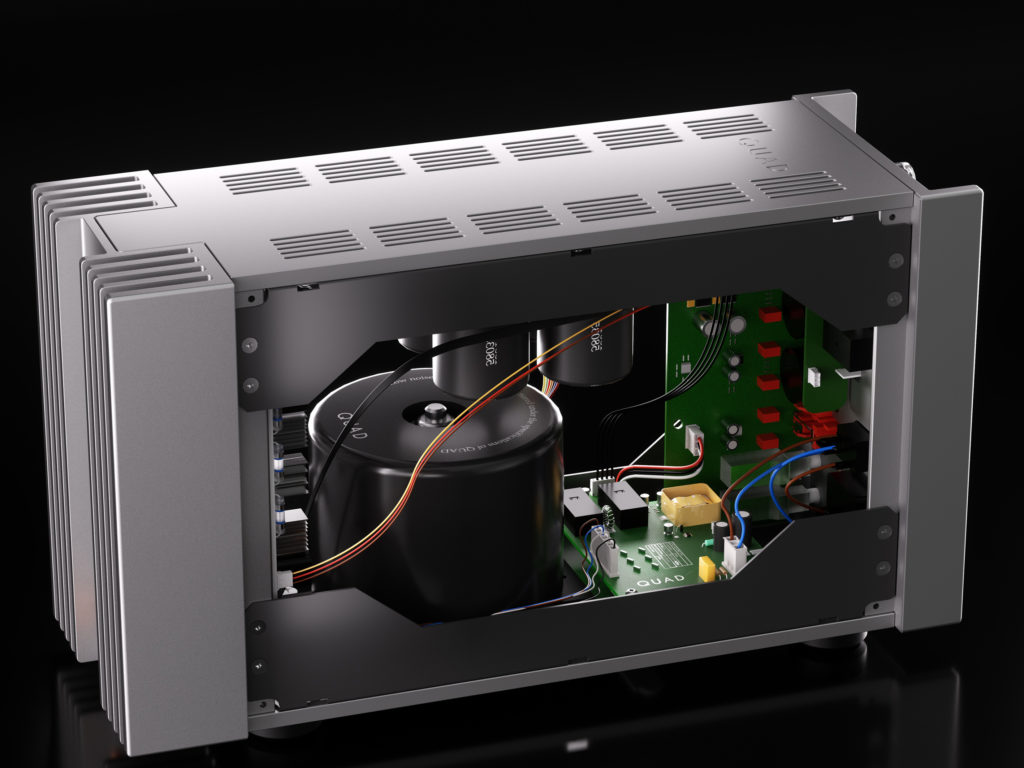
The original’s Class AB design has been thoroughly revised, including a new 200VA low-noise toroidal transformer specially developed for the new 303. QUAD’s new generation ‘triples’ design provides an advanced feedback topology for the discrete power amplifier’s output stage, delivering superior linearity and exceptional thermal stability. The result is a compact, cool-running power amplifier that possesses the capacity to deliver dynamic power and maintain a firm hold on the music while providing rich sonic detail.
The original 303 delivered 45W per channel into 8 ohms, reducing significantly into 4 ohms with current limitations which might prove problematic with some of today’s loudspeaker loads. Maintaining design continuity, the new edition does not attempt to massively ramp up the wattage in line with modern trends – doing so, especially within its classic compact form factor, would change its circuit and characteristics to such a degree that it could no longer be considered a ‘303’.
The new amp is rated at 50W per channel into 8 ohms, rising to 70W into 4 ohms – the 8-ohm figure might seem a modest increase, but a much higher maximum current delivery of 10A ensures it is highly adept at driving demanding loads. Too much attention is sometimes paid to published power outputs without considering other factors – in reality, the new 303 will drive a wide range of speakers with as much ease as a typical amp with a 100W rating, but many such amps would lack the 303’s finesse.

The new-edition 303 offers an upgrade path through the ability to connect two 303s in bridged mode, combining each amp’s two stereo channels into a single mono channel so each unit drives one speaker. This increases the power output to 140W per channel into an 8-ohm load, elevating sonic muscle and control without upsetting the 303’s beguiling finesse.
Around the back, the new 303 is equipped with high-quality gold-plated binding posts to connect speakers, a choice of RCA and balanced XLR inputs for the preamp, and a 12V trigger input for the convenience of automatic power up/down when connected to the 33 preamp’s trigger output.
Classical training. Stellar performance.
Together, the new 33 preamp and 303 power amp offer a compact and cool-running analogue pre/power pairing that is faithful to the iconic originals yet thoroughly updated inside and out. The fact that vintage 33 and 303 units made in the 1960s and ’70s remain in use today, and their sound still much admired, is testament to the ingenuity of the original designs.
The new editions celebrate QUAD’s heritage and maintain these core attributes whilst elevating them in every respect. They capture the originals’ silky sonic delivery that set them apart from other transistor based amps of the time, adding greater clarity, detail, bandwidth and dynamic impact. This pre/power amp combination is a joy to listen to, track after track, symphony after symphony, thoroughly engaging the listener whether the volume is dialled low or spun high.
The 2024-edition 33 preamplifier and 303 stereo power amplifier are available from authorised QUAD retailers from mid-November, priced at £1,199 each.
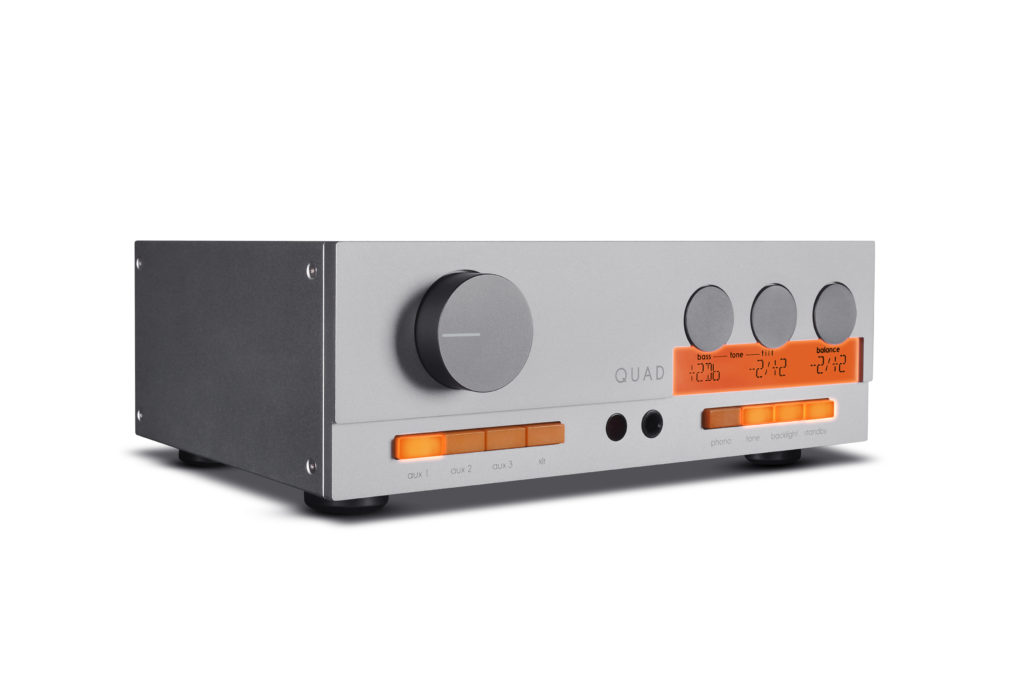
QUAD
Of all the British high-end hi-fi brands, QUAD (which stands for Quality Unit Amplifier Domestic) boasts the longest and most distinguished history. The company has been at the cutting edge of audio since 1936, pushing back the boundaries of performance with continuous innovation. In 1953, the QUAD II valve amplifier set new standards for audio amplification and three years later QUAD invented the first full-range electrostatic speaker – later known as the legendary ESL 57.
Throughout the ensuing years, QUAD products have continued to win worldwide acclaim, building a reputation for excellence that bears comparison with the most distinguished brands in any field. QUAD has been part of the International Audio Group (IAG) since 1998, following its acquisition from the Verity Group (alongside Wharfedale). The company’s design and technical support teams and much-admired servicing department continue to be based in Cambridgeshire, England, supported by key personnel who have worked with QUAD for decades.
IAG’s exceptional resources and unrivalled audio manufacturing facilities ensure that QUAD’s current range boasts many award winning products, including the latest generation of ESL electrostatic speakers, class-leading valve amplifiers, dynamic ‘box’ speakers, planar magnetic headphones and a range of solid-state audio electronics that fuse high-end performance with elegant, versatile design. 88 years after its formation, QUAD continues to be driven by the philosophy of its founder, Peter Walker, to produce “the closest approach to the original sound”. quad-hifi.co.uk

